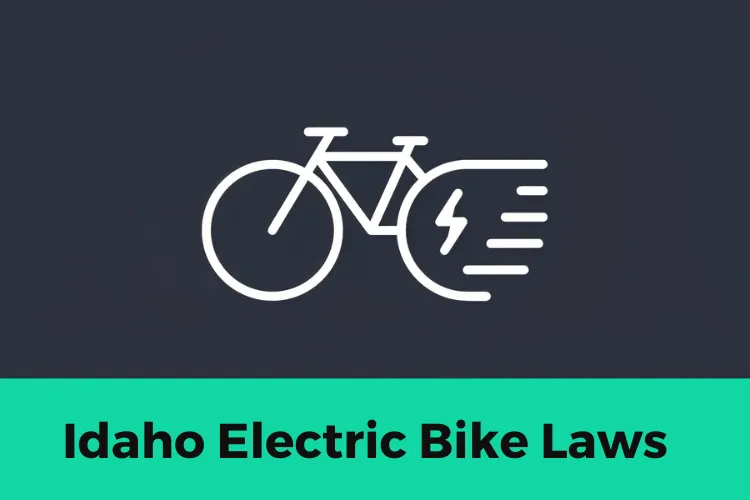Electric bikes are growing in popularity across Idaho, but the laws governing their use vary widely in each state. Understanding the specifics of Idaho’s regulations is key to riding an e-bike safely and legally. This guide will cover the essential Idaho electric bike laws including where e-bikes are permitted, how they are defined, equipment regulations, age restrictions, and more. With knowledge of the rules, an e-bike can provide all the benefits of convenience, exercise, and environmental-friendliness while conforming to all legal requirements in the state.
Definition of an Electric Bike in Idaho
Electric bikes in Idaho are categorized based on their electric motor power and speed assistance capabilities. Under Idaho statute, e-bikes are defined as bicycles equipped with an electric motor of less than 750 watts. Models with motors above 750 watts are more heavily regulated as mopeds or motorized scooters rather than e-bikes.
There are three specific classes of e-bikes recognized in Idaho:
Class 1 e-bikes have a pedal-assist electric motor that engages only when the rider is pedaling and cuts off at 20 mph. These are the most common type of e-bikes.
Class 2 e-bikes have a throttle control that can power the e-bike without pedaling up to 20 mph. These throttle e-bikes are less prevalent but legal.
Class 3 e-bikes provide pedal assistance up to 28 mph before the electric motor cuts out. These fast pedal-assist models face some usage restrictions.
All three classes of e-bikes must meet standard bicycle safety requirements including operable pedals, brakes, reflectors, and other equipment. Following these specifications and classes is key for an e-bike to be legal to operate in Idaho.
Idaho Electric Bike Laws: Everything You Need to Know

Are electric bikes street legal in Idaho?
Yes, electric bikes are legal to ride in Idaho as long as they meet certain requirements outlined in state law. Specifically, e-bikes must have pedals, and an electric motor under 750 watts, and fall under one of the three classes.
What are the different classes of electric bikes in Idaho?
Idaho recognizes three main classes of e-bikes:
- Class 1 e-bikes have a pedal-assist motor that only engages when the rider pedals. The motor cuts off at 20mph. These are the most common types of e-bikes.
- Class 2 e-bikes have a throttle control that can power the e-bike without any pedaling up to 20mph. These are less common but legal.
- Class 3 e-bikes also have pedal assist but can engage the motor up to 28mph before cutting out. These high-speed e-bikes are allowed in Idaho but face restrictions on some multi-use paths and trails.
What are the speed limits for electric bikes in Idaho?
E-bikes in Idaho must adhere to the following speed limits based on their class:
- Class 1 & 2 e-bikes: 20 mph motor-assisted limit
- Class 3 e-bikes: 28 mph motor-assisted limit
On public roads and bike paths, e-bikes are subject to the same speed regulations as regular bicycles and must obey posted speed limits. Riders should maintain safe speeds around pedestrians.
Do I need a license or insurance to ride an electric bike in Idaho?
No license or insurance is required to ride an e-bike in Idaho. They are regulated as standard bicycles under the law. However, it is still smart to have liability insurance in case an accident occurs on your e-bike.
Am I allowed to ride an electric bike on bike paths and trails in Idaho?
Generally, yes e-bikes are allowed on most bike paths and trails in Idaho, as long as those paths permit regular bicycles. However, some trails prohibit certain classes of e-bikes, so check regulations before riding. Class 1 and 2 e-bikes can ride on most multi-use paths and trails in the state, including in Idaho State Parks, except for the Lewiston Levee Parkway in Hells Gate State Park. But Class 3 e-bikes may be restricted on some trails. Contact the land manager if unsure about e-bike access.
Are electric bikes allowed in national parks and forests in Idaho?
E-bike access varies across national parks, forests, and other public lands in Idaho. For example, in Sawtooth National Forest e-bikes are allowed on most trails, but Craters of the Moon prohibits them in backcountry areas. In Yellowstone, only paved roads are open to e-bikes. The Idaho Panhandle National Forests permit e-bikes on motorized roads and trails, offering about 5,000 miles of road and 1,500 miles of trail open to motors. However, e-bikes are restricted on non-motorized trails to protect resources, since they are considered motor vehicles under Forest Service rules.
Are there any age restrictions for riding an electric bike in Idaho?
Yes, there are some age requirements for operating class 3 e-bikes in Idaho. Riders must be at least 16 years old to ride an e-bike solo.
Are there any helmet laws for electric bike riders in Idaho?
Helmet use is mandatory for e-bike riders under the age of 18 in Idaho. Adults are also encouraged to wear helmets for head protection. Make sure any child is wearing an approved helmet while on an e-bike.
What are some of the best places to ride an electric bike in Idaho?
Top e-bike destinations in Idaho include:
- Trail of the Coeur d’Alenes – 72 miles of paved trail across Northern Idaho
- Boise River Greenbelt – 25 miles of path through Idaho’s capital
- Teton Valley Pathways – Multi-use trails outside Grand Teton National Park
- Hiawatha Trail – 15 miles of downhill mountain bike trail with shuttle bus
- Sawtooth Recreation Area – Hundreds of miles of scenic forest e-bike trails
What are some of the most popular electric bike brands in Idaho?
Best-selling e-bike brands in Idaho include:
- Specialized – Makers of light-performance e-mountain bikes
- Trek – Known for quality hybrid and commuter e-bikes
- Electra – Stylish cruisers and townie e-bikes
- Ride1UP – Affordable direct-to-consumer e-bikes
- Rad Power Bikes – Top-rated cargo and fat tire e-bike models
- Aventon – Trendy bikes focused on urban riders
Also Read:- Hawaii Electric Bike Laws: Everything You Need to Know
Disclaimer
This guide provides general information about electric bicycle laws in the state of Idaho but is not meant as legal advice. E-bike regulations can vary by municipality and are subject to change. For the most up-to-date information, please check official state statutes or contact local authorities in your area. We disclaim any liability from the use or application of laws described in this guide. Riders should educate themselves on the latest e-bike rules and ride responsibly to ensure the safety of all road and trail users.

1 thought on “Idaho Electric Bike Laws: Everything You Need to Know”